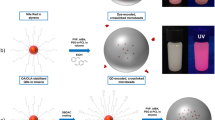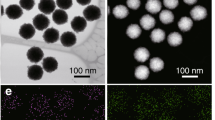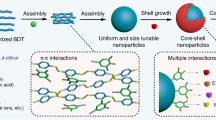Abstract
We have developed miniaturized heterogeneous Pd0-catalysts (Pd0-microspheres) with the ability to enter cells, stay harmlessly within the cytosol and mediate efficient bioorthogonal organometallic chemistries (e.g., allylcarbamate cleavage and Suzuki-Miyaura cross-coupling). This approach is a major addition to the toolbox available for performing chemical reactions within cells. Here we describe a full protocol for the synthesis of the Pd0-microspheres from readily available starting materials (by the synthesis of size-controlled amino-functionalized polystyrene microspheres), as well as for their characterization (electron microscopy and palladium quantitation) and functional validation ('in solution' and 'in cytoplasm' conversions). From the beginning of the synthesis to functional evaluation of the catalytic device requires 5 d of work.
This is a preview of subscription content, access via your institution
Access options
Subscribe to this journal
Receive 12 print issues and online access
$259.00 per year
only $21.58 per issue
Buy this article
- Purchase on Springer Link
- Instant access to full article PDF
Prices may be subject to local taxes which are calculated during checkout





Similar content being viewed by others
References
Prescher, J.A. et al. Chemistry in living systems. Nat. Chem. Biol. 1, 13–21 (2005).
Moses, J.E. et al. The growing applications of click chemistry. Chem. Soc. Rev. 36, 1249–1262 (2007).
Bertozzi, C.R. A decade of bioorthogonal chemistry. Acc. Chem. Res. 44, 651–653 (2011).
Sletten, E.M. et al. Bioorthogonal chemistry: fishing for selectivity in a sea of functionality. Angew. Chem. Int. Ed. 48, 6974–6998 (2009).
Sletten, E.M. et al. From mechanism to mouse: a tale of two bioorthogonal reactions. Acc. Chem. Res. 44, 666–676 (2011).
Streu, C. et al. Ruthenium-induced allylcarbamate cleavage in living cells. Angew. Chem. Int. Ed. 45, 5645–5648 (2006).
Agard, N.J. et al. A strain-promoted [3 + 2] azide alkyne cycloaddition for covalent modification of biomolecules in living systems. J. Am. Chem. Soc. 126, 15046–15047 (2004).
Haas, K.L. et al. Application of metal coordination chemistry to explore and manipulate cell biology. Chem. Rev. 109, 4921–4960 (2009).
Prescher, J.A. et al. Chemical remodelling of cell surfaces in living animals. Nature 430, 873–877 (2004).
Baskin, J.M. et al. Copper-free click chemistry for dynamic in vivo imaging. Proc. Natl. Acad. Sci. USA 104, 16793–16797 (2007).
Yusop, R.M. et al. Palladium-mediated intracellular chemistry. Nat. Chem. 3, 239–243 (2011).
Sánchez-Martín, R.M. et al. Bead-based cellular analysis, sorting and multiplexing. ChemBioChem 6, 1341–1345 (2005).
Sánchez-Martín, R.M. et al. Microsphere-based real-time calcium sensing. Angew. Chem. Int. Ed. 45, 5472–5474 (2006).
Cho, J.K. et al. Captured and cross-linked palladium nanoparticles. J. Am. Chem. Soc. 128, 6276–6277 (2006).
Miyaura, N. et al. Palladium-catalyzed cross-coupling reactions of organoboron compounds. Chem. Rev. 95, 2457–2483 (1995).
Unciti-Broceta, A. et al. A fluorescein-derived anthocyanidin-inspired pH sensor. Tetrahedron Lett. 50, 3713–3715 (2009).
Alexander, L.M. et al. Investigation of microsphere-mediated cellular delivery by chemical, microscopic and gene expression analysis. Mol. BioSyst. 6, 399–409 (2010).
Sarin, V.K. et al. Quantitative monitoring of solid-phase peptide-synthesis by the ninhydrin reaction. Anal. Biochem. 117, 147–157 (1981).
Acknowledgements
This work was supported financially by the Engineering and Physical Sciences Research Council (M.B.), the Swiss National Science Foundation (E.M.V.J.) and the Government of Malaysia (R.M.Y.). A.U.-B. and R.M.S.-M. thank the Medical Research Council Institute of Genetics and Molecular Medicine and the Royal Society, respectively, for funding. We are grateful to F. Thielbeer and J. Cardenas-Maestre for their helpful advice regarding the microsphere synthesis and to J. Weiss for testing the protocol.
Author information
Authors and Affiliations
Contributions
A.U.-B. designed, supervised and wrote the protocol; E.M.V.J. developed and wrote the protocol; R.M.Y. developed the protocol; R.M.S.-M. developed the protocol; M.B. designed, supervised and wrote the protocol.
Corresponding authors
Ethics declarations
Competing interests
The authors declare no competing financial interests.
Rights and permissions
About this article
Cite this article
Unciti-Broceta, A., Johansson, E., Yusop, R. et al. Synthesis of polystyrene microspheres and functionalization with Pd0 nanoparticles to perform bioorthogonal organometallic chemistry in living cells. Nat Protoc 7, 1207–1218 (2012). https://doi.org/10.1038/nprot.2012.052
Published:
Issue Date:
DOI: https://doi.org/10.1038/nprot.2012.052
This article is cited by
-
DNA-based platform for efficient and precisely targeted bioorthogonal catalysis in living systems
Nature Communications (2022)
-
Synthetic prodrug design enables biocatalytic activation in mice to elicit tumor growth suppression
Nature Communications (2022)
-
Biocompatibility and therapeutic potential of glycosylated albumin artificial metalloenzymes
Nature Catalysis (2019)
-
Cancer-derived exosomes loaded with ultrathin palladium nanosheets for targeted bioorthogonal catalysis
Nature Catalysis (2019)
-
On-cell catalysis by surface engineering of live cells with an artificial metalloenzyme
Communications Chemistry (2018)
Comments
By submitting a comment you agree to abide by our Terms and Community Guidelines. If you find something abusive or that does not comply with our terms or guidelines please flag it as inappropriate.



